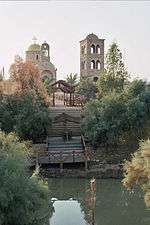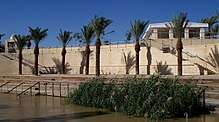Qasr el Yahud
| قصر اليهود | |
 | |
 Shown within the West Bank | |
| Alternative name | Al-Maghtas |
|---|---|
| Location | Jericho Governorate, West Bank (claimed by State of Palestine) |
| Coordinates | 31°50′18″N 35°32′21″E / 31.838333°N 35.539167°E |
Qasr el Yahud (Arabic: قصر اليهود; also Kasser/Qasser al-Yahud/Yehud etc.; lit. "Castle of the Jews", Hebrew: קאסר אל יהוד) is the official name of a baptism site in the Jordan River Valley in the Occupied Territories of Palestine. Even if the site is not in Israel the site and facilities are administered by the Israeli Civil Administration and the Israeli Ministry of Tourism as part of an Israeli national park.
It is the western part of the traditional site of the baptism of Jesus by John the Baptist (Matthew 3:13-17), in Arabic Al-Maghtas, a name which was historically used for the pilgrimage site on both sides of the river. It is also traditionally considered to be the place where the Israelites crossed the Jordan River,[1] and Elijah the Prophet ascended to heaven.[2]

Etymology
The Arabic name of the baptism site is Al-Maghtas, an area stretching over both banks of the river. The Jordanian side uses the names Al-Maghtas, Bethany beyond the Jordan and Baptism(al) Site, while the western part is known as Qasr el-Yahud. The nearby Greek Orthodox Monastery of St John the Baptist has a castle-like appearance (thus qasr, "castle"), and tradition holds that the Israelites crossed the river at this spot (thus el-Yahud, "of the Jews").[3][4][5]
History

Qasr el-Yahud is close to the ancient road and river ford connecting Jerusalem, via Jericho, to several Transjordanian biblical sites such as Madaba, Mount Nebo and the King's Highway. It is located in the West Bank, a little southeast from Jericho and is part of the Jericho Governorate of Palestine[6].
The modern site reopened in 2011 after being closed since the 1967 Six-Day War[6]. The restoration project was approved before the 2000 millennium celebrations but was delayed due to the Second Intifada and flooding in the region in 2003[1]. In 2000, Pope John Paul II landed at Qasr el Yahud in a helicopter and held private worship at the site.[1]
Qasr el Yahud is administered by the Israeli Civil Administration and the Israeli Ministry of Tourism. Before the site became accessible, baptisms took place at Yardenit.
See also
References
- 1 2 3 Ginat, Gitit (January 14, 2010). "Take me to the river". Haaretz. Retrieved August 1, 2017.
- ↑ "Jesus's baptismal site, long sealed off, to be cleared of landmines". The Times of Israel. May 16, 2016. Retrieved August 1, 2017.
- ↑ "Survey of Western Palestine, sheet 15". Palestine Exploration Fund. Retrieved 23 March 2015.
- ↑ Theodosios Mitropoulos, architect. "The Holy Monastery of St John the Baptist on the banks of the Jordan River/Qasr-el-Yahud". The [Greek Orthodox] Patriarchate of Jerusalem – Official News Gate. Retrieved 23 March 2015.
The Holy Monastery of St John the Baptist on the banks of the Jordan River/Qasr-el-Yahud […] The perimeter walls, specifically their uppermost portion, terminate at battlements, which lend the monument the form of a Medieval castle. This is in all likelihood why its Arab name is Qasr el Yahud [The castle of the Jews]
- ↑ Othmar Keel; Max Küchler; Christoph Uehlinger (1992). Orte und Landschaften der Bibel, Volume 2. Vandenhoeck & Ruprecht. p. 528. ISBN 9783525501672. Retrieved 23 March 2015.
- 1 2 "In rivalry over Jesus' baptism site, UNESCO backs Jordan over West Bank, as debate goes on". Fox News World. Al-Maghtas, Jordan. Retrieved August 1, 2017.
External links
| Wikimedia Commons has media related to Kasser Al Yahud. |
Coordinates: 31°50′18″N 35°32′21″E / 31.83833°N 35.53917°E